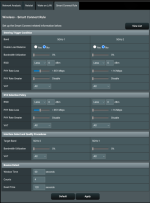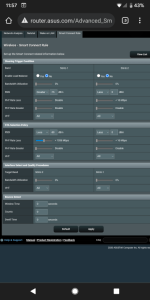Androidian
Occasional Visitor
I'm trying to steer most devices to high band 5ghz-2 from 5ghz-1. I'm using dual band smart connect with 5ghz only (5ghz-1 & 5ghz-2) and not with 2.4ghz. The default settings weren't working for me. But after a lot of guess and check, these settings seem to be working (screenshot). But I don't understand why for "Interface Select and Qualify Procedures" the "Bandwidth Utilization" needs to be at 0% for both bands (5ghz-1 & 5ghz-2). After checking the "missing manual," it says "STAs meeting the STA selection policy criteria for the radio will be steered to the first target if that radio's Bandwidth Utilization is LESS than the set value." In other words, 0% = radio is not in use. So wouldn't you want to put it high so that it will usually steer STAs that meet the criteria? Thanks again for any help!



